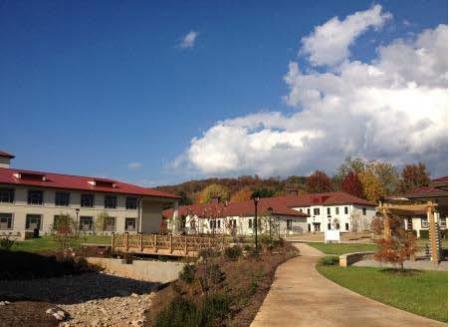
This post celebrates the 40th anniversary of the Smithsonian National Zoo's Conservation Biology Institute. We are also celebrating 50 years of conservation science at the Zoo.
In 1959, veterinarian
Dr. Theodore H. Reed became director of the Smithsonian’s
National Zoological Park. The Zoo had survived the trying years of the Great Depression and World War II, so Reed’s early days were spent improving the collection. But he had a larger plan to meet the unfulfilled mandates of the National Zoo's founders for research, education, and conservation of endangered species. Gradually he built up a staff of researchers who studied animal biology, nutrition, reproduction, and behavior. In 1965, he hired the Zoo's first resident scientist, ecologist John Eisenberg, to focus on the mammals of Neotropics. It was clear that zoo life was stressful for many animals and interfered with reproduction. Reed had seen the London Zoo’s facility at Whipsnade – not ideal but it did allow animals to live quietly in natural groups. He decided to develop an even better facility in the United States to carry out Zoo founder
William Temple Hornaday’s commitment to conservation of species on the brink of extinction.
In the early 1970s, he got the green light from Smithsonian Secretary
S. Dillon Ripley, also an ardent conservationist. He looked at several sites but found all had significant drawbacks, until Smithsonian Institution Press director Ted Rivinus suggested he look at a shuttered USDA Cattle Station in Front Royal, Virginia. When Reed saw it, he thought he "had died and gone to heaven." Over 3,000 acres set in the rolling hills and blue skies of western Virginia, it contained barns, paddocks, woods, and buildings for staff. Hidden by a screen of woods, it was a quiet refuge for animal species under duress. They were given a temporary permit in January 1974, and three scimitar-horned oryx took up residence. Forty years ago, on June 22, 1975, the Conservation and Research Center (CRC) of the National Zoological Park was formally launched. Its first director,
Chris Wemmer, set it on course. In 1975, more hoofed stock arrived, including Grants zebra, Pere David deer, onangers, and Eld’s deer. The animals immediately abandoned the nuclear family groups they were kept in, forming female breeding herds and bachelor herds. Shy animals like Eld’s deer thrived in quiet locations.
Guy Greenwell arrived to care for the birds and successfully hatched nineteen Hawaiian geese the first year.
Devra Kleiman began a maned wolf breeding program. Reproductive physiologist
JoGayle Howard pioneered new techniques for assisted reproduction with remarkable success. The facility was not opened to the public to ensure the health and safety of such critically endangered species as Guam rails, clouded leopards, and black-footed ferrets. Staff scrub and use protective gear when working in those enclosures.
CRC director Wemmer established ethology programs to study animal behavior at the zoo facilities and in the wild in 25 foreign countries. In 1981 Wemmer initiated a Wildlife Conservation and Management Training Program for zoo and wildlife managers from across the globe. Coordinated by biologist Rudy Rudran, wildlife managers from developing nations came for extended study and formed relationships with their cohort of classmates that often lasted the remainder of their careers. Eventually the training programs expanded to the new joint Smithsonian Conservation Biology Institute (SCBI)/George Mason University conservation training center.

Today, the SCBI (formerly CRC) stands on 3200 acres outside of Front Royal, Virginia, home to more than 400 animals, including 17 mammalian and 15 avian species. SCBI facilitates and promotes research programs based at Front Royal, the National Zoo in Washington, D.C., and at field research stations and training sites worldwide. Although not open to the public for most of the year (SCBI holds an open house for the public the first weekend of October each year), occasionally when driving down the road adjoining the specialized facility, you can catch a peek of an oryx or Przewalski’s horse grazing peacefully among the rolling hills.
Related Resources
Related Collections






Leave a Comment